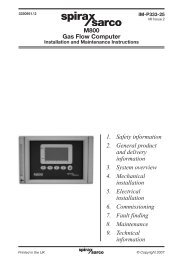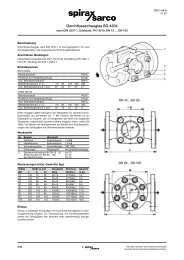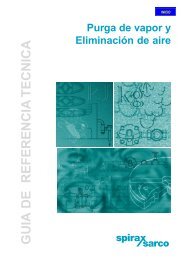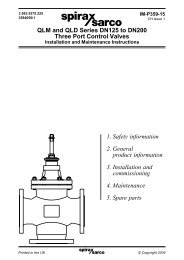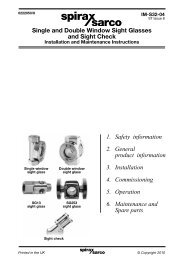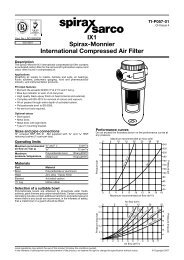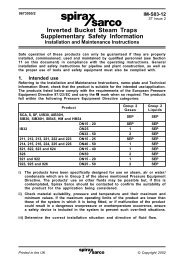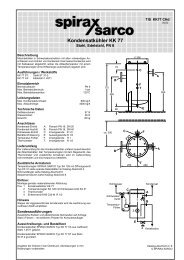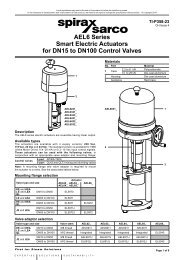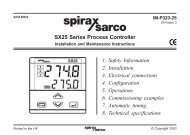2000 Hook-up Book - Spirax Sarco
2000 Hook-up Book - Spirax Sarco
2000 Hook-up Book - Spirax Sarco
Create successful ePaper yourself
Turn your PDF publications into a flip-book with our unique Google optimized e-Paper software.
Meter Location<br />
Meters need to be installed in<br />
defined lengths of straight pipe to<br />
ensure accurate and repeatable<br />
performance. These pipe lengths<br />
are usually described in terms of<br />
the number of pipe diameters<br />
<strong>up</strong>stream and downstream of the<br />
meter. For example, an Orifice<br />
Plate with a Beta ratio of 0.7<br />
installed after a 90° bend requires<br />
a minimum of 28 pipe diameters<br />
of straight pipe <strong>up</strong>stream and 7<br />
downstream. If the pipe diameter<br />
is 6", this is equivalent to 14 feet<br />
<strong>up</strong>stream and 3-1/2 feet downstream.<br />
If the meter is located downstream<br />
of two 90º bends in<br />
different planes, then the minimum<br />
straight length required<br />
<strong>up</strong>stream of the meter is 62 pipe<br />
diameters or thirty one feet. This<br />
can be difficult to achieve, particularly<br />
in fairly complex pipework<br />
systems, and there may not in<br />
fact be a location that allows<br />
these criteria to be met. This is an<br />
important consideration when<br />
selecting a meter.<br />
Table 19 shows the minimum piping<br />
requirements for Orifice<br />
Plates as laid down in the US<br />
standard ASME MFC-3M together<br />
with the manufacturers<br />
recommendations for vortex and<br />
spring loaded variable area<br />
meters. See Figures II-93, 94, 95,<br />
96 (pages 131 and 132).<br />
Steam Meters<br />
Table 19: Recommended Minimum Straight Lengths (D) for Various Meter Types<br />
On Upstream (inlet) side of the primary device Downstream<br />
Meter Type ß Single Two 90° Bends Two or more 90° Bends Reducer Expander Globe Valve Gate Valve All Fittings<br />
Ratio (3) 90° Bend Same Plane Different Planes 2D to D 0.5D to D Fully Open Fully Open in this table<br />
Orifice Plate 0.30 10 16 34 5 16 18 12 5<br />
Orifice Plate 0.35 12 16 36 5 16 18 12 5<br />
Orifice Plate 0.40 14 18 36 5 16 20 12 6<br />
Orifice Plate 0.45 14 18 38 5 17 20 12 6<br />
Orifice Plate 0.50 14 20 40 6 18 22 12 6<br />
Orifice Plate 0.55 16 22 44 8 20 24 14 6<br />
Orifice Plate 0.60 18 26 48 9 22 26 14 7<br />
Orifice Plate 0.65 22 32 54 11 25 28 16 7<br />
Orifice Plate 0.70 (4) 28 36 62 14 30 32 20 7<br />
Orifice Plate 0.75 36 42 70 22 38 36 24 8<br />
Orifice Plate 0.80 46 50 80 30 54 44 30 8<br />
Vortex (1) N/A 20 - 40 20 - 40 40 10 - 20 10 - 35 50 20 - 40 5 - 10<br />
Spiraflo (2) N/A 6 6 12 6 12 6 6 3 - 6<br />
Gilflo (2) N/A 6 6 12 6 12 6 6 3 - 6<br />
Gilflo SRG (2) N/A 6 6 12 6 12 6 6 3 - 6<br />
Gilflo ILVA (2) N/A 6 6 12 6 12 6 6 3 - 6<br />
Notes:<br />
1. The table shows the range of straight lengths recommended by various Vortex meter manufacturers.<br />
2. Downstream requirements are 3D and 6D when <strong>up</strong>stream are 6D and 12D respectively.<br />
3. ß ratio = Orifice diameter (d) divided by Pipe diameter (D)<br />
4. Most Orifice Plates are s<strong>up</strong>plied with a ß ratio of around 0.7 which gives the best pressure recovery without compromising signal strength.<br />
61<br />
SYSTEM DESIGN



